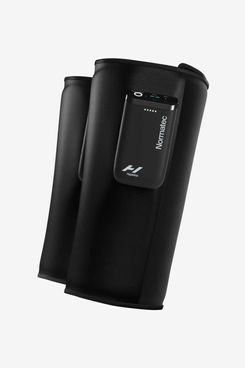
A decade ago, you would only really see compression boots being used by professional athletes like LeBron James and Chloe Kim — or you might find them at sports-medicine or medical facilities. But in recent years, these boots, which are meant to improve circulation and reduce muscle soreness, have become a trendy recovery tool for at-home use, even though some pairs run upward of $600.
The best-known compression boots, and the ones you see most on pros, are Hyperice’s Normatec 3. They work by inflating in a sequence, starting with pressure in chambers around the foot, and working up to the thigh. They work somewhat like the compression devices that have been used for decades to help with lymphatic circulation in cancer and lymphedema patients, and that sequential pumping is what’s important, says Amanda Palmeri, a doctor of physical therapy at NYU Langone who specializes in cancer-related lymphedema. Unlike the Normatecs and a few other compression boots, some of the generally much cheaper ones simply squeeze all at once.
While compression technology can be useful in specific medical settings, the jury’s still out on just how useful compression boots are for general recovery. For most of us, Matt Klein, DPT and professor of physical therapy at West Coast University Center for Graduate Studies, believes they’re not going to move the needle much. “Brief 30-to-45-minute use of the pneumatic pressure devices may provide some temporary relief, but is not going to have as big a benefit as active exercise,” he says, adding that adequate rest, nutrition, and active recovery will go much further.
Given that they may not do much, are they worth it? I’ve used Normatecs myself, both at physical therapy and at home, with a pair the company sent me to test. I like how they feel and think they help somewhat in reducing post-workout muscle soreness, but I can’t imagine shelling out $800 for them. There are many less-expensive options available now, including some on Amazon that run under $100, and I was curious to see how they compared to the Normatec 3. I tested a handful of different boots over the past few months and chatted with experts and Strategist staffers about the pairs they tested, too. Here’s what you can expect to get at a variety of price points.
The Normatec 3 is one of the most popular compression boot models, and multiple runners have told me the Normatec boots are a big ticket item on their wishlist.) I’ve been using them for about six months, primarily working them into my rest days for marathon training, as well as using them for a half hour before bed. In total, I use them about three to four nights a week.
With consistent use in addition to my regular recovery routine, my legs have felt noticeably less sore after tough workouts. (In this regard, testing the boots was similar to my cold plunge testing — the supposed benefits became clearer with more use: A single session in the compression boots won’t do much, nor will a single dip in the cold plunge.) Maria Wong, co-founder of running group Queens Distance Runners, says her Normatec boots — which she got on sale in 2020 — are the best running-related gift she’s ever purchased for herself. “Yes, they’re an investment, but they’re so worth it. And I really feel the difference in using them after a long run or some type of hard effort. My legs do feel less tired and less sore and less tight after I use them,” she says.
While none of the experts I spoke to recommended these boots for lymphedema treatment, the Normatec boots do inflate in a sequence, as Palmeri told us was important to these devices’ effectiveness in promoting lymphatic drainage. On its remote control, which connects through tubes to each sleeve, you can choose from seven pressure levels and five different zones (chambers) to inflate. I found the highest pressure setting to be the most intense out of all the models I’ve tried. Some people I’ve talked to have compared the Normatec’s pressure to that of a massage, but I think it’s a different sensation. Massages target specific areas and work into your muscles, whereas the feeling of the Normatec’s pressure is more like a comforting tightness around the entire leg — it hugs them, and I often feel my pulse in my legs — and then it releases like a big sigh, and repeats the cycle.
While I found the Normatec boots to be effective, the cost might be hard to justify if you’ll only be using them occasionally. Most people likely won’t need this pair if they just want something to help with swelling, or something to wear after light exercise. Instead, I’d recommend one of the pairs below.
One popular model among the more affordable options is the Renpho Leg Massager, which attaches to your thighs and calves with a Velcro strap. Unlike the other models in this list, they also heat up, which I found relaxing (this could be a helpful feature if you have poor circulation and frequently feel cold). I’ve tested the Renpho for a month using them a few times a week for about 20 minutes to a half hour, and while they work as advertised, they are significantly less powerful than the Normatec or the Therabody JetBoots. When inflated, their max strength feels like the lowest setting of those other two.
Strategist senior editor Jen Trolio, who has been using the Renpho for over two years after soccer games, describes them as “moderately effective,” adding that “these don’t help with knee stuff much, but I am convinced that the heat and the compression help everywhere else on my legs.”
Both Trolio and I found them hard to get adjusted correctly. “I’m not rail-skinny or anything, but I am generally straight-size and I find the Velcro adjust is sometimes hard to tighten enough on my thighs in particular,” she says. “Conversely, if you adjust them too tight, they can start to kind of open up as the compression inflates them (this is more likely to happen on my calves).” One additional drawback is that the Renpho boots do not inflate sequentially — they inflate all at once. So if you were to use them for help with lymphatic drainage, they wouldn’t be as effective as a model like the Normatec.
But the Renpho boots are more affordable than any model in this list. If you’re looking for boots that can help relax your legs, then I think these are a great option. But if you’re looking for a device that does something more intense, then these boots will not fit the bill. “Do these get an absolutely glowing review from me? No. Do they look like a weird Iron Man exo-skeleton kind of suit? Yes,” says Trolio. “Do I still kind of love them anyway and look forward to using them, especially for the $80 to $90 I paid? Sure do.”
The JetBoots are another popular model that I’ve been testing alongside the Normatec boots over the last month. The main difference between the two is how easy the JetBoots are to put on and get going. There are no connective tubes that need to hook up to the sleeves, since the compression devices are in the heels of each boot, so I just zip them up and press the buttons on either sleeve (the settings sync automatically) to start my session. They can also be operated either as a pair, or separately.
The JetBoots have four intensity settings, and while they offer close to the same intensity (on their max setting) as the Normatec, they doesn’t compress my legs for as long. (They inflate sequentially and reach their most intense level only for a few seconds before deflating and beginning the cycle again.) Another added benefit of these sleeves (and the majority of the boots in this list) is how they force me to actually sit down and rest — while they’re inflated, you can’t flex your legs or get up and walk around, so I often throw these on when I watch TV or play video games on the couch. Similar to the Normatec, I would recommend these for athletes who work out frequently, or for people who would use them often.
If you mainly want compression for a specific area and not your entire leg, a smaller, more portable device like the Normatec Go might be a better option than a pair of full leg sleeves. The Go is meant to be used around the calves. “I definitely feel a difference when I do or when I don’t use them. I usually like to use them after a long run (for me that’s a run that’s 8 to 10 miles or more, when marathon training) to prevent soreness the next day,” says Strategist newsletter editor Ashley Wolfgang. “Depending on the mileage and workout, my legs can also feel pretty beat right after a run and the Nomatec Go provides immediate relief that can’t be 100 percent achieved when using, say, a foam roller.”
The Normatec Go is good for those who travel, not only because they fit in a carry-on, but because you can flex your knee and still wear them while seated, like on a plane. “I also like how you’re able to target specific areas with the Go boots,” Wolfgang says. “I have what seems like forever tight calves and when I’m short on time and just want to relieve tight calves post-run, these are the perfect thing.”
The Strategist is designed to surface the most useful, expert recommendations for things to buy across the vast e-commerce landscape. Some of our latest conquests include the best acne treatments, rolling luggage, pillows for side sleepers, natural anxiety remedies, and bath towels. We update links when possible, but note that deals can expire and all prices are subject to change.










